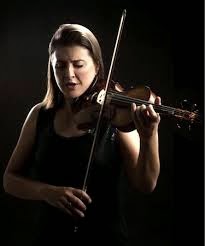Nadja Salerno-Sonnenberg lends a touch of eccentricity to disciplined Russian orchestra's Palladium concert
At this late date, it may seem like the crudest kind of piling on to add my tongue-clucking voice to the extensive critical commentary on Nadja Salerno-Sonnenberg's stage appearances and musical interpretations. The American violinist has been before the public since she was barely out of her teens, and she is now 53.
Only a hard heart could be totally unsympathetic to her, ever since the kitchen accident she sustained as a rising star that sidelined her career and threw her into suicidal depression years ago. Still, we are left with what to make of the kind of impression she made Friday night at the Palladium in a guest appearance with the touring Moscow State Symphony Orchestra.
An artist's having surmounted personal struggles can never be the whole story. The main focus has to
 |
| Nadja Salerno-Sonnenberg: A diary approach to Bruch |
The anxiety about the health of classical music has recently reached fever pitch. Back when Salerno-Sonnenberg was forging her reputation as a free spirit and exporting it to the mass public in the course of several appearances on "The Tonight Show" with Johnny Carson, she was symbolic of a new classical spirit overflowing with personality. Her early career thus attained a weight and breadth that helped tamp down the controversy about how she chose to represent the music — and how she looked when doing so.
Wearing a red blouse and sparkly black trousers, Salerno-Sonnenberg was a full-bore performer from top to toe in her Carmel engagement. By the finale, she punctuated tutti passages (when the soloist is idle) with a bit of disco swaying to the beat. In the first movement, she chose to play along with the violins in the tuttis, an unusual choice in a romantic work. Her shoulder-length hair, in need of one, possibly two, barrettes, regularly flopped into her face and had to be swept back. The pained intensity of her facial expressions — once regularly commented upon by critics — seemed a minor matter in comparison.
More stoic performers can sometimes strike the public as stuffed shirts. This violinist is definitely at the other end of the spectrum. The projection of a strong personality is not out of place in classical music. But the irony is that a performer bent on demonstrating she is "really into the music" may render the audience less so. The audience, I suspect, becomes more "into" the soloist's being into the music.
So what about her concept of the Bruch? Salerno-Sonnenberg took to an extreme the composer's qualms about calling this piece a concerto rather than a fantasy. There's such a seductive, free-flowing layout, especially in the first two movements, that the soloist felt free to indulge in lots of introspection. Much of this came through in extreme dynamics, mostly at the soft end of the spectrum. The first-movement entrance of the violin — marked "forte" in the score I have — came out as a pianissimo tendril.
Extremely soft playing was frequent elsewhere, sometimes in cadences whose near-inaudibility weakened the line's structural integrity. Salerno-Sonnenberg's overall approach, combined with a tense, fast vibrato, amounted to a "Dear Diary" interpretation of the Bruch G minor. Conductor Pavel Kogan was hard-pressed at times to keep his mighty orchestra from covering the soloist. Still, there seemed to be a remarkable meeting of the minds in this performance,
That can be put forward as a credit to Kogan's control of his disciplined Russian ensemble. The string sections (the listed names totaled more than I could see) were larger than we are used to hearing in this sadly reduction-in-force era for American orchestras. The full-orchestra sound Friday was immensely powerful, with strings in such numbers making a more than adequate counterweight to brass and percussion. Woodwind voices were more individualistic than we are used to hearing in the best American orchestras, but their coordination was so perfect that the result was a keen blend.
The Overture-Fantasy "Romeo and Juliet" opened the concert — fiery and tender, as appropriate. It would be hard to hear sharper rhythmic definition in the "conflict" episodes than was evident in this performance. Accents of foreboding made the introductory material especially thrilling. The love theme, among several Tchaikovsky melodies that have attracted pop composers, was beautifully laid out by English horn and violas.
After intermission came the tumultuous and innovative Fourth Symphony (in F minor, op. 36). The kind of sprightly playing that was later confirmed by two contrasting encores was foretold in a well-knit account of the Scherzo, with its pinpoint, dynamically subtle string pizzicati and the cheery unanimity of the wind instruments. The outsize emotions of the first and fourth movements were fully engaged, but at no sacrifice of ensemble unity. In this repertoire, at least, the Moscow State Symphony Orchestra under Kogan's direction sounded solidly world-class. And with Salerno-Sonnenberg in the spotlight, the visiting musicians showed they could be gracious hosts as well.



Comments
Post a Comment